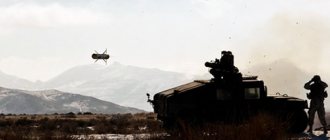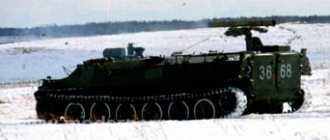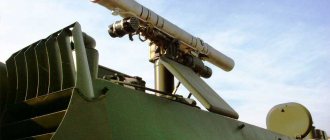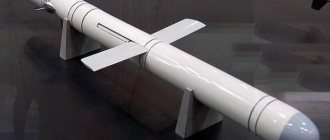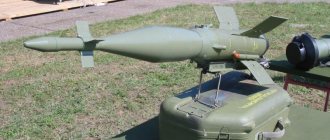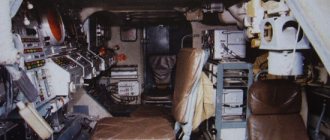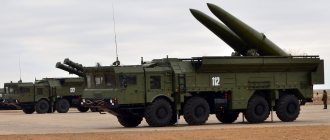The FGM-148 Javelin is an anti-tank system that arose in response to new methods of warfare. A smart missile is capable of flying to a target in a fully autonomous mode and hitting it at its weakest point, from above.
The gun operates on a “soft” launch system, which makes it possible to shoot from indoors. Guidance is carried out in passive mode, and the operator can be sure that the enemy is not able to detect the approach of the warhead, and the sensitive eye can detect a target in absolute darkness from a distance of several kilometers. All this makes Javelin the ideal embodiment of technical excellence and simply an effective means of destroying any equipment.
History of creation
In the mid-1970s, M-47 Dragon guided missiles began to enter service with the US Army to combat heavy equipment. It was a second-generation complex with its inherent disadvantages. One of them is the need to keep the target in the crosshairs throughout the flight of the projectile. This allows the station to track the missile's beacon relative to the target and adjust its course.
It is obvious that operators of such systems become a priority target, and the experience of Arab-Israeli soldiers has shown that ATGM positions are subject to massive fire immediately after launch. On the other hand, armored vehicles began to be equipped with optical-electronic suppression systems, which complicated guidance along the line of sight.
It became clear that a fundamentally new solution was needed, the rocket of which would have its own guidance, independent of the station. In the early 1980s, a series of programs was approved to develop a new generation complex. The main requirements of the military for developers were:
- crew survivability – minimal operator presence on the battlefield;
- a new level of penetrating ability - defeating new types of Soviet tanks with dynamic armor;
- minimum firing range – 2 km;
- minimum level of visual visibility and acoustic noise when firing;
- possibility of use from shelters or buildings;
The new weapon had to be qualitatively better than the “Dragon”, while remaining in the same dimensions, since they were proposed to be equipped with landing forces and motorized infantry.
Several companies took part in the competition and presented their solutions.
Table of competition participants
| Prototype | Topkick | Dragon-2 | Fog-M | Javelin | Striker |
| Company | Ford Aerospace | McDonnell Douglas | Hughes Aircraft | Texas Instruments | Raytheor |
| Rocket control | Semi-auto | Semi-automatic | Manual | Auto | Auto |
| Guidance device | Laser illumination | Wired transmission | Wired transmission | IR GOS | IR GOS |
| Ability to adjust target after launch | Available | Available | Available | No | No |
| Change of position | No | No | Can | Can | Can |
Based on the results of the competition, the Javelin was chosen as the winner, after which the company was given time to assemble the first batch. During testing of the first production samples, it became clear that their characteristics were noticeably worse than the competition prototype and no longer met the requirements.
The production facilities of Texas Instruments were not suitable for the mass production of such complex products, and subsequently the right to production, along with the technological equipment, was purchased by the company, which made changes based on its developments.
History of the development of Javelin weapons
Oddly enough, the history of the creation of this modern ATGM goes back to the Cold War. Despite the general decrease in the intensity of passions between the two poles of that world, they hoped for the worst. Thus, in 1986, the project to create a light anti-tank weapon, the Tank Breaker, was nearing completion. Many companies took part in the competition for a new portable ATGM - from large and eminent ones to very small, practically garage teams engaged in the development of individual modules of future weapons.
A detailed 3D model of the Javelin complex, fully consistent with the real weapon. Special attention should be paid to the wings of the rocket
According to analysts, in the event of a military clash between the troops of the Warsaw Pact countries and NATO, the main actions will take place in Berlin, which left a certain imprint on the possibility of their course.
Urban combat is very specific and places special demands even on hand-held firearms, not to mention anti-tank systems.
The main requirement was the possibility of firing from enclosed spaces, that is, the shot should not create excess pressure or a jet of flame that could harm the shooter himself or other people in the room. The task was complex, but, as it turned out, it was quite doable, with a fairly simple solution. Much more complex were other requirements, which were constantly added and refined during the development of the project to create a new generation ATGM.
Examples include the invisibility of a missile's trace from its launch site, the ability to fire at low-flying helicopters, the capture and guidance of a target by a missile, the ability to choose the behavior of a missile to hit certain targets. In other words, the list was made up of tasks, each of which required a separate unique solution that had not been used before or existed only as an idea.
ATGM in equipped condition. Of particular interest is the missile itself with guidance sensors under a polymer ballistic tip
Based on the developments and general ideas of the Tank Breaker project, the FGM-148 Javelin was created. This project cannot be treated as a product of one company. This is a combination of many developments, the result of the work of many people, each of whom worked on some separate component of the future weapon.
General description of the FGM-148 Javelin
“Javelin” is a new generation ATGM operating on the “fire and forget” principle. Designed to destroy tanks, vehicles and even helicopters.
Guidance is carried out according to the thermal radiation of the target in automatic mode.
The device includes two modules:
Transport and launch container (TPC) and command and launch device (KPU).
The TPK is a disposable launch pad in the form of a tube with the rocket itself in it, while the KPU is a module containing controls, optical instruments, power supply, and can be used repeatedly with other TPKs.
Command-Launch Device (in English CLU)
The KPU includes:
- Night sight based on a thermal imager.
- Optical sight.
- Handles with control elements.
- Stirling's engine.
- Visir.
- Battery BA-5590/U for powering systems.
The main working element of the ATGM is a thermal imaging camera that forms an image regardless of weather conditions. The sensor has a resolution of 240 x 480 pixels.
To register weak thermal radiation from a target, it is necessary that the camera lenses and matrix are sufficiently cold, otherwise the useful signal will dissolve in its own thermal noise. To solve this problem, the sight is equipped with a cooling unit powered by a miniature Stirling engine. The required time for complete cooling is 2 minutes 35 seconds.
The matrix is located in a Dewar flask with a vacuum, which may leak over time and therefore the developer reports a limited storage time of 10 years. The CPU sensor can operate without cooling if the target has sufficient thermal contrast.
Two data connectors are located on the right side: the first for connecting to a simulator or updating software and the second for transmitting data to the rocket. At the bottom there are two pistol-type handles, on which the shutter button, sharpness controls, changes in the sensitivity limit and other display parameters are located.
The display in early versions was with a cathode ray tube, but starting in 2006 they began to be replaced with LED ones.
The image from the camera is displayed in the center of the viewfinder, and various indicators are located around the perimeter:
- Day – Day sight;
- WFOV – night sight with 4x magnification;
- NFOV – night sight with 12x magnification;
- SEEK – view from the camera of the rocket itself (viewfinder). The viewfinder turns on after placing the marker;
- TOP – attack from above is selected;
- Dir (Direct) – direct attack is selected;
- FLTR – reflection filter enabled;
- NIGHT – The thermal imager is not cooled;
Red indicators indicate insufficient cooling temperature, battery voltage, or autodiagnostic errors.
Pressing the FLTR button brings up a special filter. The Javelin's large lenses, like any other optical sight, reflect the laser beam well. This reflection is recorded by special devices such as “Anti-sniper”, which are used by reconnaissance officers. This could pose a threat to the life of the operator even before the shot is fired, which is why the optics were equipped with a similar filter.
The filter should be used only when necessary - its main disadvantage is the deterioration of the sensitivity of the thermal imager.
All of the above devices require power, for which the BA-5590/U battery is provided. If there is no power supply, you can only use an optical sight for observation.
Transport and Launch Container
The launch tube is made of graphite fibers to reduce weight. Ammunition is mounted in the TPK at the assembly stage, where it is connected to cooling tubes and covered with lids. The rocket is equipped with its own cooling from compressed gas cylinders, and does not depend on the general cooling system.
The capacity of the gas tanks is limited and will only last for four minutes of operation, during which time it is necessary to hit the target.
The time required to cool the IR seeker is 10 seconds.
ATGM FGM-148 Javelin: what is good and what is bad
In 1996, the latest anti-tank missile system FGM-148 Javelin entered service with the US Army. This was the first production ATGM of the new third generation; Due to a number of new functions, it differed favorably from existing systems. Subsequently, these complexes were actively used in various conflicts and demonstrated their potential. Javlin was found to have both strengths and weaknesses.
Technical features
The FGM-148 complex includes two main elements - a command and launch unit and a transport and launch container with a guided missile.
Before use, the block and container are connected, after which preparations for launch and firing are carried out. The empty disposable container is then discarded and replaced with a new one. The command and launch unit is a device with optics (day and night) and electronics for firing control. The main means of searching for a target is a thermal imaging camera of limited resolution. A telescopic sight was initially used as an additional channel. During the next modernization in the early tens it was replaced with a video camera.
The FGM-148 missile is built according to a normal aerodynamic design. The cylindrical body houses folding wings and stabilizers. The missile is equipped with a cooled infrared homing head, providing fire-and-forget operation. A tandem cumulative warhead with a penetration rate of at least 600-800 mm behind dynamic protection was used.
The rocket on its trajectory accelerates to 190 m/s. With the use of the command block of the first version, the firing range is limited to 2.5 km; the modernized version made it possible to increase it to 4 km. After launch, the missile rises to a certain height corresponding to the firing range, and then dives towards the target. For the greatest effectiveness of destruction, the product hits the upper hemisphere - the least protected part of a modern armored vehicle.
"Jevlin" in combat position has a length of approx. 1.2 m and diameter no more than 450-500 mm. Weight – 22.3 kg. The calculation of the complex includes two people. At the same time, the characteristic ergonomics allow the use of such an ATGM by one soldier. If necessary, the complex can be used with a tripod machine or with a carrier machine.
Main advantages
The FGM-148 ATGM has a number of obvious advantages that distinguish it from other systems in its class.
First of all, these are small dimensions and weight, making them easier to carry and use. The crew can quickly and easily take up a firing position, find and attack the target. Then you can change the TPK and fire a new shot or leave the position. The command and launch unit uses optical means, incl. thermal imager. This allows you to search for and attack targets at any time of the day, and also provides resistance to electronic warfare and some types of smoke screens. Before the recent modernization, the ATGM did not have a laser rangefinder and did not unmask itself with radiation.
A characteristic feature of the third generation of ATGMs, which includes the Javelin, is the missile’s autonomous seeker, which implements the fire-and-forget principle. After launch, the missile independently tracks the target and aims at it. Thanks to this, the crew has the opportunity to quickly begin preparing for the second shot or leave the position before a retaliatory strike.
The missile carries a tandem warhead with high armor penetration rates. According to the stated characteristics, the missile is capable of hitting most modern tanks head-on, as well as any outdated armored vehicles, incl. equipped with dynamic protection. In this case, a special flight trajectory is used, which allows you to get into the least protected projection of the target and most fully realize the potential of the warhead.
Thanks to its combination of characteristics and capabilities, the Javlin can fight a wide range of targets. First of all, these are the enemy’s medium and main tanks. It is also possible to defeat armored vehicles of any other classes. If necessary, shooting at low-altitude, low-speed targets such as helicopters is allowed. The main requirement for the target is contrast in the infrared range and being within the fire zone.
Significant disadvantages
With all its advantages, the FGM-148 ATGM is not without its drawbacks.
The main thing is the highest cost of all its elements, incl. expendable. From this point of view, Javelin is “superior” to any other modern anti-tank systems. US military budget for FY2022. provides for the purchase of missiles from the TPK at the rate of 175 thousand dollars per unit. The price of the command and launch unit has long exceeded 200 thousand. The high cost of consumable ammunition affects both combat use and personnel training. Even the Pentagon, with its record budgets, is forced to limit the number of practical launches during training and maneuvers, as well as expand the use of training complexes.
The missile of the complex does not have high flight performance characteristics. First of all, it limits the firing range. Even a modernized ATGM has a range of only 4 km, which is significantly less than the range of competing foreign developments. However, even such a range allows the crew not to be afraid of return fire from small arms and reduces the risks associated with enemy artillery.
The relatively low speed makes the missile more vulnerable to the effects of active protection of the target tank. A flight to a distance of 2.5 km takes more than 13 seconds, and the armored vehicle’s automatic equipment receives a significant margin of reaction time.
The seeker of a fire-and-forget missile is not without its drawbacks. Thus, there are known examples of combat use of anti-tank systems in which the missile was unable to hold the target and missed. According to known data, the reason for this was insufficient contrast between the targets and the surrounding area. In this case, the operator does not have the opportunity to adjust the trajectory or redirect the missile to another object.
The command and launch unit uses only optical instruments, which limits its observation capabilities. Modern smoke screens easily disrupt optics and hide potential targets. The upgraded version of the unit has a laser rangefinder to improve the accuracy of calculations, but its beam unmasks the ATGM. Having detected radiation, the target tank can activate suppression means or respond with a shot.
Overall potential
The FGM-148 Javelin ATGM entered service with the developing country almost a quarter of a century ago. Subsequently, this product went into mass production and was actively used by troops in exercises and in real operations. There were many export contracts. Approx. was released for all customers. 10-12 thousand command blocks and more than 45 thousand missiles.
During its operation, Jevlin showed its capabilities.
Its positive qualities were confirmed - but the personnel constantly had to deal with serious restrictions of various kinds. Because of this, the operation of anti-tank systems turns out to be quite expensive, and the defeat of a training or real target is not guaranteed. In general, the FGM-148 can be considered a fairly successful - and advanced for its time - development in the field of infantry anti-tank weapons. The widespread use of advanced technologies has made it possible to obtain high combat potential. However, its implementation requires complete and effective training of personnel, as well as the competent use of weapons on the battlefield.
Several years ago, the basic ATGM was modernized, which made it possible to improve some of its characteristics - primarily the launch range and reliability of optical-electronic systems. By now, based on the experience of operating weapons, there is a need for a new update. As a result of such events, Javelin will be able to get rid of all the main shortcomings and once again become one of the most effective anti-tank systems in the world.
However, even in its existing form, the FGM-148 has long and firmly taken its place in armies and on the international arms market. Political factors were of no small importance, but technical and operational characteristics also made their contribution. Further improvement of the design, as well as maintaining support from the army and military diplomats, will allow the Javelin product to maintain or even improve its position in the world.
FGM-148 missile
The missile is equipped with a 127 mm caliber tandem warhead. Correction of the projectile during flight is provided by the aerodynamic tail.
Structurally, the ammunition consists of several parts: a homing head, a control unit, engines and a fuel tank.
Aiming head
The homing head is located in the nose of the missile. It is based on a cooled IR sensor with a resolution of 64 x 64 pixels. Cooling of the sensor during flight is provided by a built-in reservoir, which is filled from the TPK during pre-launch preparation.
The operating temperature of the matrix is within -186 degrees Celsius. The head processor is capable of processing up to 180 frames per second, which is the minimum scan rate at this flight speed. Further, during the flight, the algorithm compares each new frame with the previous one and makes adjustments if there are horizontal displacements.
The sensor is not sensitive to optical-electronic interference such as Shtora-1, since such systems only block xenon lamps of older generation complexes.
However, metallized aerosol smoke can become an obstacle to it.
Following the IR seeker is a flight control unit, the core of which is the ESAF electronic fuse. The mechanism will not allow a launch if the pre-launch preparation rules are not followed, and will also prevent the warhead from detonating if it misses. Another task of the control unit is to issue corrections to the engine nozzle based on corrections received from the processor.
Warhead
Most modern tanks are equipped with mounted dynamic armor, which consists of explosive packages placed around the perimeter of the vehicle. A directed explosion disperses the jet of a cumulative projectile and to overcome such protection, the missile has two charges: the first to destroy the explosive package and the second to penetrate the armor itself.
Both charges are located at a distance from each other and separated by a protective partition. In the absence of dynamic protection, the penetrating effect of both charges is summed up. The caliber of the main charge is 127 mm, which is smaller than the caliber of the second generation ATGM. The fact is that the penetration ability directly depends on the length of the cumulative jet, which in turn depends on the diameter of the funnel.
The length of the jet on average is equal to the caliber multiplied by 4 and the resulting value must exceed the thickness of the armor.
For a javelin, the value does not exceed 600 mm, which means that the front armor plates of the tank cannot be penetrated. To compensate, the developers make a funnel from molybdenum, since it is heavier than copper and this promises certain advantages.
Engines
The rocket is knocked out of the tube by the propellant charge, after which the propulsion engine fires. This solution allows fighters to use it from enclosed spaces, avoiding gas contamination. The main engine accelerates the device to approximately 900 meters, after which the flight continues by inertia and could reach a range of 5 km, if there were sensitive guidance electronics.
When choosing an attack from above, the propulsion engine raises the rocket to a height of 160 m and holds it until it enters the attack at an angle. During the last 50 m, the engine nozzle deflects the shot several times in a zigzag pattern, which in theory should help overcome active protection systems. If the target is lost behind aerosol smoke, the system will try to complete the flight at the last saved point.
Starting procedure
Pre-launch preparation of anti-tank systems includes:
- Open the cases, attach the launching device (KPU) and the launch tube (TPK);
- Switch the toggle switch to on mode and activate the cooling system;
- Find the target in the optical eyepiece, capture it on the display using a marker;
- Select the flight option “Top” or “Direct”;
- Press the release button;
- Leave the position and disconnect the control unit for further use;
Advantages and disadvantages of the FGM-148 Javelin
Advantages:
- the ability to change position after a shot;
- completely passive guidance, without the use of laser illumination. The launch can only be detected visually or using radar;
- indifference to optical-electronic suppression systems;
- “Top” flight mode, in which the missile hits equipment from above;
- “Soft” launch allowing work from buildings;
- destruction of aircraft such as a helicopter or drone. Unlike specialized air defense systems, Javelin requires an accurate hit, since the warhead does not contain fragmentation submunitions;
- ability to work in difficult weather conditions (fog, sandstorm).
Flaws:
- inability to change target after shooting;
- high cost ($120,000 per shot);
- relatively short firing range;
- difficult guidance when using a smoke screen with metallized aerosols;
- difficult to use on streets and neighborhoods;
- low penetration effect, in comparison with its predecessors;
- relatively long pre-launch preparation.
Destruction of fortifications, although possible, is ineffective. The FGM-148 does not have special thermobaric rounds for such purposes, and those available do not cause significant damage.
The FGM-148 is especially effective against Soviet tanks with an automatic loader, such as the T-90 or T-72. By piercing the thin armor plate of the roof, the jet can hit the ammunition rack, which is located in a carousel at the bottom of the hull. The carousel is not isolated from the tower in any way and in the event of detonation the crew will most likely die.
Anti-tank generations
Anti-tank guided missiles appeared at the end of World War II. In 1943, work began in Germany on the Ruhrstahl X-7 (“Little Red Riding Hood”) ATGM. The matter did not reach the start of mass production; this was prevented by the end of the Third Reich. However, German developments fell into the hands of the Allies and already at the end of the 40s, anti-tank systems appeared, which are traditionally considered to be the first generation of these weapons. This includes, for example, the SS-10 (France) and “Cobra” (Switzerland) complexes. The Soviet Union joined this race somewhat late, but quickly caught up with its Western competitors and already in 1960 adopted the Shmel anti-tank complex, and in 1963 the Malyutka. Moreover, contrary to the proverb, the first pancake turned out to be very good: the Soviet “Malyutki” were used quite successfully in Vietnam, and in 1973 they staged a real pogrom against Israeli tanks during the Yom Kippur War.
The design of the first generation ATGM was imperfect. The missiles had low speed, insufficient firing range, and there was a significant “dead zone” in the initial part of the trajectory. But their biggest drawback was the complexity of management. It was carried out by wire, and the operator, using a joystick, had to directly control the rocket. One awkward movement - and a very expensive ATGM simply stuck into the ground. Therefore, firing from anti-tank systems like the Malyutka required very high training of the crew.
Therefore, already in the 70s, second-generation ATGMs with a semi-automatic guidance system began to enter service. These complexes could control the rocket in flight via a wire, a laser beam or a radio channel. But now it was enough for the operator to hold the target after the shot in the sight; the missile was guided in flight by the automatic weapons. The second generation of ATGMs includes the Soviet complexes “Fagot”, “Konkurs”, the Russian “Cornet”, the American “Tow” and “Hellfire”, as well as most other anti-tank systems currently in service with various armies of the world. Some of them, however, are designated 2+ (sometimes even 2++), but this is rather a marketing ploy that does not reflect the real state of affairs.
In the early 90s, work began in several countries on the creation of third-generation anti-tank missile weapons. Its main feature is a fully automatic missile control system, which fits into the “fire and forget” concept. It is on this principle that the American Javelin ATGM operates. To be fair, the FGM-148 Javelin is not the only third generation anti-tank system in existence, it is simply the most famous of them. This group also includes the Israeli ATGM Spike and LAHAT, the German PARS 3 LR and the Indian Nag.
In addition to the third, some authors also identify a fourth generation of anti-tank systems. These include anti-tank systems with loitering ammunition capable of circling over the battlefield. The task of the operator of such a complex is only to select a suitable target through a television communication channel and direct a missile at it. So far there is only one production model of such a weapon - the French MMR ATGM; some complexes from the Israeli Spike family can be partially included in this group.
Comparative Specifications
| Kornet-M | FGM-148 | Scythian | |
| A country | Russia | USA | Ukraine |
| Caliber | 152 | 127 | 152 |
| Minimum distance to target, m | 100 | 500 | 100 |
| Maximum firing range day/night, km | 5.5/3.5 | 2.5 | 5.5/3 |
| Warhead | tandem cumulative, thermobaric | tandem cumulative | tandem cumulative |
| Ability to penetrate armor, mm | 1000—1200 | 600 | 1100+ |
| Pointing method | Laser illumination Semi-automatic | IR GOS | Laser beam Semi-automatic (possibility of firing from remote control |
| Maximum rocket flight speed, m/s | 300 | 190 | 220 |
| Launch tube length, mm | 1210 | 920 | 1435 |
| ATGM weight | 55 | 26,0 | 76,5 |
The competitive advantages of the FGM-148 over the Kornet and Skif are mobility and ease of use, but it is much inferior to them in range. Russian and Ukrainian vehicles do not need to be aimed at warm objects, which makes them a universal solution for defending or assaulting fortified positions.
On the other hand, the laser beam of the Kornet and Skif is detected by the most primitive sensors, while the launch of a missile with a thermal head can only be detected by radar, which is not currently installed on any production tank.
Due to their weight and size characteristics, neither the “cornet” nor the “skiff” are suitable for use by reconnaissance forces or foot units.
It is important to understand that the Israeli “Spike” is a whole family of complexes, and for comparison, an option similar to the “Jevlin” in weight was chosen. A special feature of “Spike” is the “fire, adjust, forget” principle. The Japanese model is inferior in almost all respects except price.
Other characteristics of FGM-148 are presented in the table
| Rocket length, mm | 1081,2 |
| Rocket mass, kg | 11,8 |
| Weight of the control unit, kg | 6,36 |
| Pre-launch preparation time, s | 30 |
| Time to install a new launch tube, s | 20 |
| Calculation, persons | 1-2 |
The large mass of the sighting device is explained by the presence of a battery and various mirror drives in the optical system. The missile is one of the lightest among its competitors and its mass is almost three times less than the Kornet, while the weight of the complexes themselves is approximately the same.
Combat use and prospects for use
The Javelin ATGM was first used during the coalition invasion of Iraq. During the fighting at the Debakka Pass, special forces used a portable complex and destroyed 14 pieces of equipment using only 19 shots. The record target engagement range in this war was 3,700 m.
ATGMs have also found widespread use in Afghanistan in counter-guerrilla operations, occupying a niche between mortars on the one hand and grenade launchers on the other. Operators carried out targeted strikes on DShK positions, on the mouths of caves, and even on crowds of people.
The KPU was often used as a reconnaissance device, thereby establishing the complex as a completely universal solution. It is planned to deliver the batch to Ukraine, where it will presumably be used against T-72 tanks of the B3 modification (2011) in the east of the country.
The Javelin anti-tank missile system has not yet had time to fully demonstrate its capabilities in real battles, as was the case with the TOW ATGM during the Vietnam War.
The experience of local battles has shown the comparative mobility, and most importantly, the accuracy of Dzhevelin. The complex changed the nature of warfare. This is the secretive appearance of small groups, targeted destruction of targets, without the use of aircraft, and rapid evacuation.
Since 2013, the supply of parts with new control units with a laser target designator and GPS receiver began. These measures will allow the rocket, in the event of loss of the thermal image, to continue its flight based on data from the laser range finder received before launch. Also, new equipment will expand the interaction of troops and improve its reconnaissance properties.
It becomes possible to distribute targets between crews and simultaneously defeat them, which makes the complex a universal response to the challenges of modern warfare.
Combat use of the Javelin system
After the first combat use of the ATGM, it became clear that the field tests did not lie. Even heavily armored Soviet equipment, which had previously been provided by the Soviet Union to other countries, could not withstand missile hits.
Modern tanks with active armor also could not do anything against the complex. However, ATGMs cannot withstand the simplest and most effective methods of defense against homing missiles.
For example, a dense smoke screen prevents the operator from locking onto a target; the spraying of small metal particles when an incoming missile is detected completely masks the tank and its infrared radiation. The question of identifying the missile itself also remains open, since the heat signature from the engine makes it possible to determine not only the presence of a missile in the air, but also to predict its possible targets.
One example of hitting a target tank
As for the direct use of weapons by the crew itself, experience has shown that one person can cope with an ATGM, however, combat crews are usually composed of 2-3, since the mass of the complex and ammunition is quite large.
Despite its high cost, the Javelin ATGM has repeatedly proven its effectiveness in combat and that it is worth the money spent on it. Of course, there are cheaper analogues, however, in terms of the totality of their characteristics, they are often worse or have a design that does not provide for the possibility of further deep modernization.
You can often find individual videos showing how an ATGM fails to cope with its task, but in contrast to them there are tens of times more materials proving the opposite. Well, the fact that over the 23 years of operation of the weapon there were sometimes mistakes is absolutely not surprising.
